Did you know that some roads and places in Singapore are named after trees? Deepen your understanding of Singapore’s natural heritage by going on a road trip with your child to visit these places!
Jalan Binjai and Binjai Park
Jalan Binjai is a small street located in the east, off Haig Road, just behind Tanjong Katong Primary School, while Binjai Park, Binjai Hill, Binjai Walk, and Binjai Rise are located in Bukit Timah.
These roads and places are thought to be named after the Binjai tree (scientific name: Mangifera caesia). This tree has been cultivated in the region for food. The young leaves can be used to prepare ‘lalab’, a vegetable dish. The fruits can be eaten fresh, and can also be made into juice. They are also used as an ingredient in the preparation of ‘sambal’, a type of chilli-spice mixture, or ‘rojak’, a fruit and vegetable salad dish. There is also a Binjai Heritage Tree within the compounds of a home owner at Binjai Park!
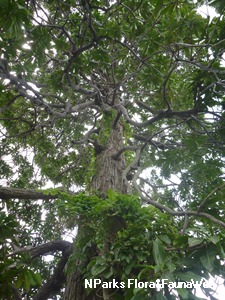
The Binjai tree is a large tree which can grow up to a height of 45 m.

The Binjai tree has been cultivated for its edible fleshy fruit.
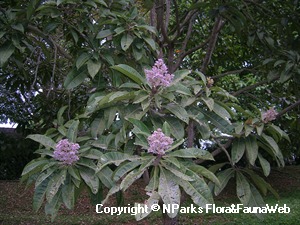
Its lilac flowers are borne on inflorescences, which can be up to 40 cm long.
Kampong Glam
Kampong Glam is a neighbourhood in Singapore that is closely associated with the Malay Community. Kampong Glam was originally land set aside for Sultan Hussein Mohammed Shah and his family members in 1823, upon his signing the treaty ceding Singapore to the East India Company. On 7 July 1989, Kampong Glam was gazetted as a conservation area.
Kampong Glam is thought to be named after the Gelam tree (scientific name: Melaleuca cajuputi). The leaves of the Gelam tree can be used to extract ‘cajuputi oil’ or ‘tea tree oil’. It has been thought that the species name cajuputi is a combination of ‘kayu’ (‘wood’ in Malay) and ‘putih’ (‘white’ in Malay), due to the tree’s white, flaky bark. This tree has been used in traditional medicine in the region to treat a variety of ailments such as rheumatism and asthma.
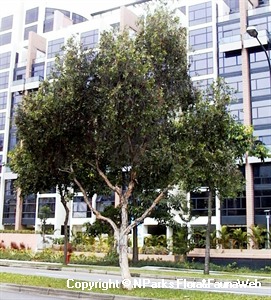
The Gelam tree is an evergreen tree that can grow up to 40 m tall.
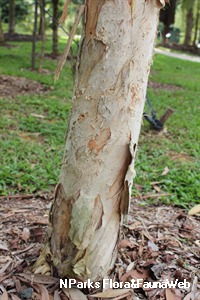
The bark is of the Gelam tree is white and flaky.

The off-white flowers of the Gelam are small, and can be found in dense spikes.
Katong
Katong, a neighbourhood that can be found in the east of Singapore, is a favourite local haunt of Singaporeans seeking good food. In particular, Tanjong Katong Road runs through this neighbourhood, spanning a length of about 3 km.
Katong gets its name from the Katong tree (scientific name: Cynometra ramiflora). This tree produces hard timber, which has been used in construction. Its timber has been used only locally, because this tree is only available in small quantities.
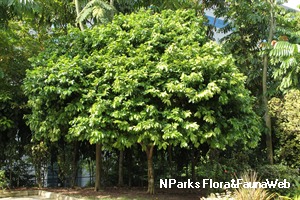
The Katong tree has a rounded crown, and can grow up to 26 m tall.

Its fruit pods are brown, scaly, and wrinkled.
Kranji Road
Kranji Road, a two-way road, begins from the junction of Woodlands Road and Turf Club Avenue and ends near Kranji Loop. The street is famous for the horse races at the Singapore Turf Club.
Kranji Road gets its name from a local tree, the Kranji or Keranji tree (scientific name: Dialium indum), which was found in abundance all over Singapore in the first half of the 19th century. The Kranji tree is also known as the Velvet Tamarind tree, so named because the flavour of its fruit is similar to the Tamarind (scientific name: Tamarindus indica).
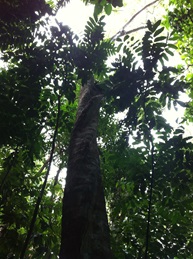
The Kranji tree can grow up to 40 m tall.
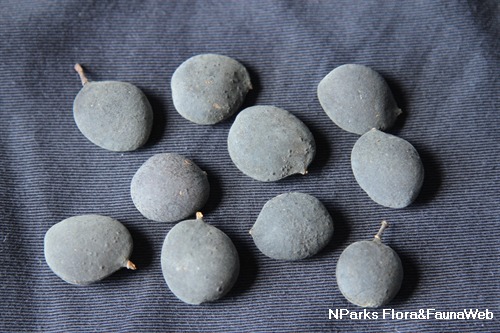
Its blue-black fruits are round or egg-shaped, with a brittle, hairy fruit wall.
Nutmeg Road
Did you know that Orchard Road’s name was derived from the Nutmeg (scientific name: Myristica fragrans) plantations that used to line the road in the 1800s? Nutmeg, used to be an important cash crop during Singapore’s colonial days when spices were worth their weight in gold. Today, Nutmeg plantations can no longer be found at Singapore’s key shopping destination, but Nutmeg Road, a small road off Orchard Road, still remains to this day.
The Nutmeg is an evergreen tree native to the Moluccas, also known as the Spice Islands, in Indonesia. This tree prefers well-drained, acidic loamy soils. Two different spices can be made from the Nutmeg tree – nutmeg, which is made from the seed, and mace, which is made from the red aril covering the seed.
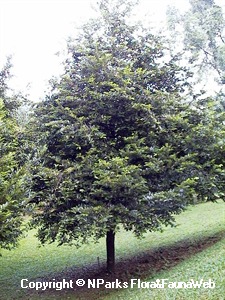
The Nutmeg tree can grow up to 23 m in height.
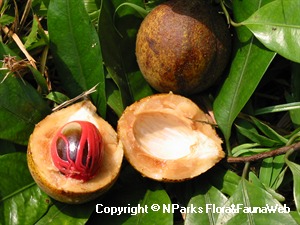
The fruit contains a seed covered in a red lacy aril, nestled in an aromatic yellowish husk.
Sembawang
Sembawang is a housing estate located in the north of Singapore. Sembawang Road, spanning about 8 km, connects this housing estate to Upper Thomson Road.
This place is named after the Sembawang tree (scientific name: Mesua ferruginea). The Sembawang tree is a tall strangly tree that often grows next to streams or flowing rivers in forests.
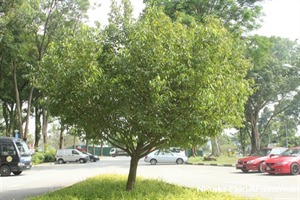
This particular Sembawang tree can be found at the carpark of Sembawang Park.
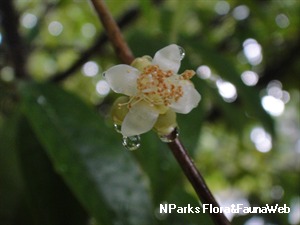
The flower is white, with numerous stamens in the centre.
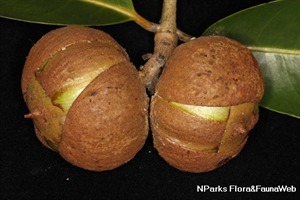
Its fleshy fruits are round, and encased in enlarged, leathery sepals.
Tampines
Tampines is a well-developed, densely-populating housing estate located in the east of Singapore. Tampines Road, spanning around 6 km, connects this housing estate to Upper Serangoon Road.
The name ‘Tampines’ is derived from the Ironwood tree known to the locals as Tempinis (scientific name: Streblus elongatus), that grew abundantly in this area in the old days. The Tampines tree is monoecious, meaning that it produces both male and female flowers on the same tree. Its flowers are insect-pollinated. Its seeds and fruits are known to be eaten and dispersed by monkeys. The tree is grown for its timber, which is heavy, strong and durable.
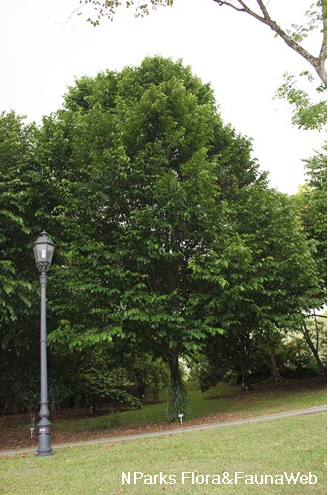
The Tampines tree has a rounded crown, and can grow up to a height of 35 m.
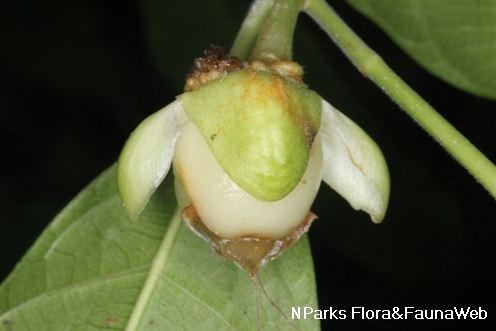
The fruit is whitish, round or ellipsoid (egg-shaped), and is 1‒1.3 cm long.
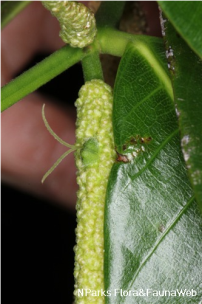
The female flowers of the Tampines tree looks like a green ball borne on a white cluster, with two ‘arms’ sticking out.
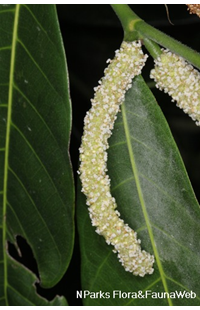
The male flowers are numerous, small, and appear whitish.
Tembusu Road and Jalan Tembusu
Tembusu Road, Tembusu Crescent, Tembusu Drive and Tembusu Avenue are a cluster of roads that can be found on Jurong Island.
On mainland Singapore, Jalan Tembusu is a small road off Haig Road, found in the east of Singapore, just next to Jalan Binjai, another road also named after a tree.
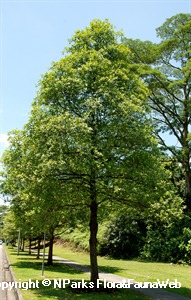
When young, the Tembusu has a fairly conical crown. As it grows, its crown assumes a more irregular shape.
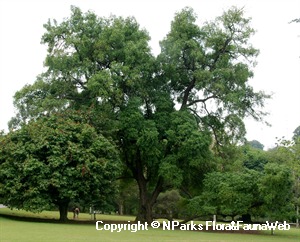
The Tembusu tree in the photo above is featured on the back of Singapore $5 note (Portrait Series). It is listed as a Heritage Tree and can be found in the Singapore Botanic Gardens.

The Tembusu has fragrant, cream-coloured flowers.

Birds and bats feed on the red berries of the Tembusu.

The Tembusu has a very distinctive fissured bark.
References
Photo Credits
Binjai Tree, Photographed by: Ang Wee Foong, Copyright © NParks Flora&FaunaWeb
Binjai Fruit, Photographed by: Ang Wee Foong, Copyright © NParks Flora&FaunaWeb
Binjai Flower, Copyright © NParks Flora&FaunaWeb
Gelam Tree, Copyright © NParks Flora&FaunaWeb
Gelam Trunk, Photographed by: Jennie Tang Yurue, Copyright © NParks Flora&FaunaWeb
Gelam Flowers, Photographed by: Teo Siyang, Copyright © NParks Flora&FaunaWeb
Katong Tree, Photographed by: Ang Wee Foong, Copyright © NParks Flora&FaunaWeb
Katong Fruit, Copyright © NParks Flora&FaunaWeb
Kranji Fruit, Photographed by: Ang Wee Foong, Copyright © NParks Flora&FaunaWeb
Nutmeg Tree, Copyright © NParks Flora&FaunaWeb
Nutmeg Fruit, Copyright © NParks Flora&FaunaWeb
Sembawang Tree, Photographed by: Ang Wee Foong, Copyright © NParks Flora&FaunaWeb
Sembawang Flower, Photographed by: Soh Weijing, Copyright © NParks Flora&FaunaWeb
Sembawang Fruit, Photographed by: Ang Wee Foong, Copyright © NParks Flora&FaunaWeb
Tampines Tree, Photographed by: Jennie Tang Yurue, Copyright © NParks Flora&FaunaWeb
Tampines Fruit, Photographed by: Ang Wee Foong, Copyright © NParks Flora&FaunaWeb
Tampines Female Flower, Photographed by: Ang Wee Foong, Copyright © NParks Flora&FaunaWeb
Tampines Male Flower, Photographed by: Ang Wee Foong, Copyright © NParks Flora&FaunaWeb
Tembusu Tree, Photographed by: Tee Swee Ping, Copyright © NParks Flora&FaunaWeb
Tembusu Tree (featured on back of $5 note), Photographed by: Tee Swee Ping, Copyright © NParks Flora&FaunaWeb
Tembusu Flower, Copyright © NParks Flora&FaunaWeb
Tembusu Fruit, Photographed by: Tee Swee Ping, Copyright © NParks Flora&FaunaWeb
Tembusu Bark, Photographed by: Tee Swee Ping, Copyright © NParks Flora&FaunaWeb